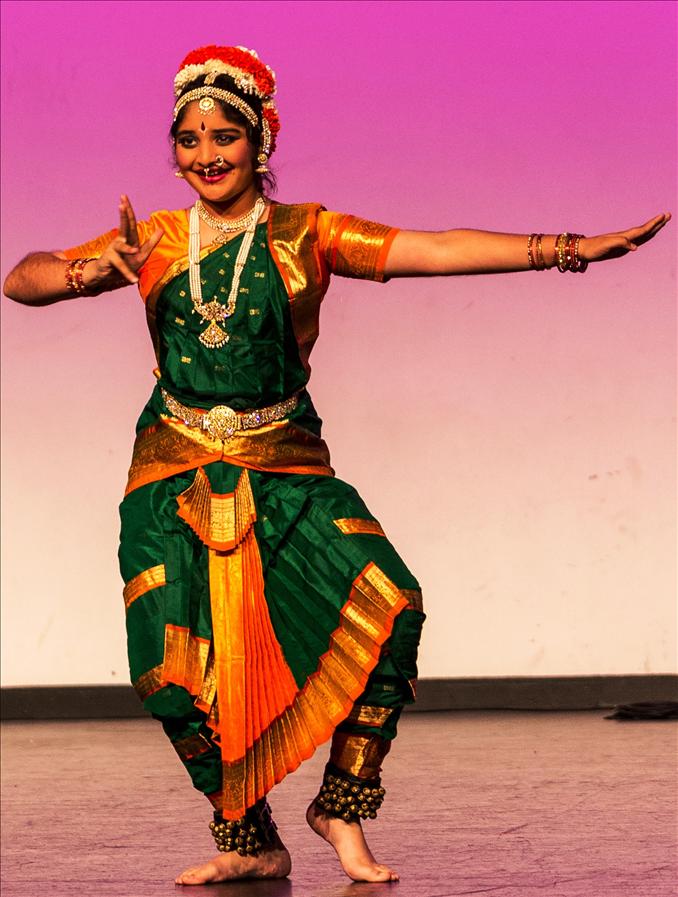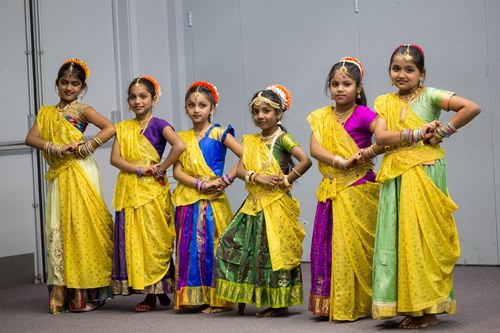The wealth of talent inherent in our children was showcased at a colourful event organised by the New Zealand Telugu Association last week.
Called, ‘Tri-Festival, the event, held at Avondale College Auditorium in West Auckland on October 27, bringing joy and pride to elders, parents and children.
At the heart of the Festival, which combined the ‘Formation Day of Andhra Pradesh,’ Dassera and Diwali, was an innate desire among the officials of the Association and long-serving members to foster the spirit of unity and traditional values in the younger members of the society, who do not have the benefit of living in their homeland.
The current Committee, led by President Srinivas Panuganti, is also keen to establish a permanent office with library and other facilities for the Association to not only serve as a common place of visit by members and the public but also to conduct Telugu Language and other classes for children.
 Variety entertainment
Variety entertainment
The Tri-Festival, which offered triple pleasure of culture, custom and cuisine, also demonstrated the spirit of love and sacrifice shown by parents towards their children.
The Festival was essentially that of children, who occupied the centre-stage, presenting and participating in a programme that offered variety and quality.
This Reporter was a Guest of Honour at the event.
The evening began with ‘Veukondama,’ a Keerthana composed by Annamacharya, , followed by a traditional dance in praise of Lord Nataraja, the ‘Emperor of Dance.’
As well as a number of dances in the traditional Indian Classical styles, the evening provided entertainment to appeal to the wider audience with several popular songs from Telugu, Hindi and Tamil films.
Young performers
All the children performed well above the standard expected for their age but mention must be made of five-year old Sudhiksha Ravooru who sang with confidence and competence a popular number from ‘Dasavatharam’(Mukunda, Mukunda); and Avantika and Sankeerthana were equally adept in performing ‘Mama, Mama’(Manchi Manushulu).
The three plus hours programme included a judicious mix of songs, dances and comedy. Among the participants were Aakaash, Abhinay, Aditi, Akshita, A’liya Musa, Arjun, Aryaman, Azim, Bhaskar, Chinnari, Dheeraj, Greeshma, Harshavardhan, Harshini, Harshita Bheema, Harshith, Jahnavi, Ketan, Kinjel Bhoir, Medha Shiva, Nandika Nelluri, Navaneeth, Praveen Ravela, Puja Nori, Rajeswari Kotte, Ranga, Rao Garu, Satvika, Smyraan, Sreya Kidambi, Sridevi Pusarla, Sriharish Kotte, Srinivas Acharya Kidambi, Sushma Kuncha, Swathi Gopi and Vedant
Unique history
Andhra Pradesh is blessed with rich historical heritage and a prosperous economy of the present, working towards a progressive future.
The first historical records appear in the Buddhist text ‘Anguttara Nikaya,’ according to which the current Nizamabad and Adilabad Districts of the Telangana region constituted parts of the Assaka Mahajanapada (700–300 BC).
An Andhra tribe was mentioned in epics ‘Aitareya Brahmana’ (800 BC) and Mahabharata (400 BC). The ‘Natya Sasthra,’ written by Bharata in First Century AD also mention the Andhra people.
There was also mention of Telugu Language on inscriptions found near the Guntur District and from others dating to the rule of Renati Cholas in the 5th Century AD.
In an effort to gain an independent state based on the linguistic and protect the interests of the Andhrites, Activist Potti Sreeramulu went on a programme of ‘fast until death’ in 1952.
The JVP Committee (named after Pandit Jawaharlal Nehru,  Vallabhai Patel and Pattabhi Sitaramayya) said in its 1949 Report that “The Andhra Province could be formed, provided that the Andhrites forfeited their claim to Madras City (now Chennai). But after Mr Sreeramulu’s death, Andhra Pradesh was carved out of Telugu speaking areas of Madras State on November 1, 1953, with Kurnool as its capital.
Vallabhai Patel and Pattabhi Sitaramayya) said in its 1949 Report that “The Andhra Province could be formed, provided that the Andhrites forfeited their claim to Madras City (now Chennai). But after Mr Sreeramulu’s death, Andhra Pradesh was carved out of Telugu speaking areas of Madras State on November 1, 1953, with Kurnool as its capital.
The State Reorganisation Commission recommended that the residual Hyderabad state (Telangana) should continue as a separate state.
On the basis of a ‘Gentlemen’s Agreement on November 1, 1956, the Telugu-speaking areas of the former Hyderabad State, also known as ‘Telangana,’ merged with Andhra to form Andhra Pradesh, with Hyderabad as the Capital.
Moves to split
There were several movements to invalidate the merger to form two states, namely Andhra and Telangana in 1969, 1972 and 2013. The 1969 movement was held in the Telangana region where 369 people died in police firings and the 1972 movement was in the Andhra region.
Following hectic political developments in 2012 and during the current year, the Congress Working Committee resolved on July 30, 2013 to request the Central Government to form the State of Telangana. The Federal Cabinet cleared the proposal on October 3 and sent the proposal to the Andhra Pradesh State Assembly for discussion and ratification.
The proposal will also be submitted to Parliament later this year, and if approved, Telangana will become the 29th State in India and Hyderabad will serve as a common Capital for both States.
Rich resources
Andhra Pradesh has the longest coastline of 972 kms (604 miles) among all the states of India. Two major rivers, Godavari and Krishna, run across the state.
The small enclave (30 square kms (12 sq miles) of Yanam, a District of Pondicherry lies in the Godavari delta in the Northeast. The State comprises three regions, namely, Telangana, Coastal Andhra and Rayalaseema.
According to 2011 Census, Hyderabad, Visakhapatnam, Guntur, Vijayawada, Rajahmundry, Warangal and Nellore were among the most populated cities in the current Andhra Pradesh.






